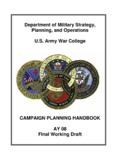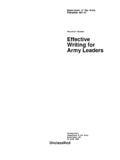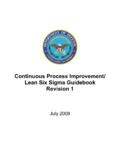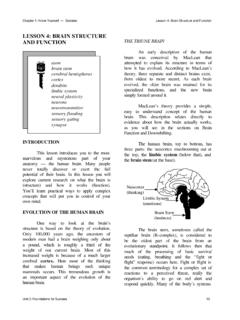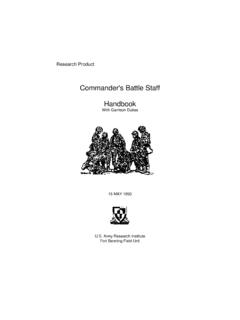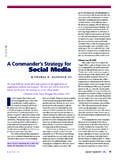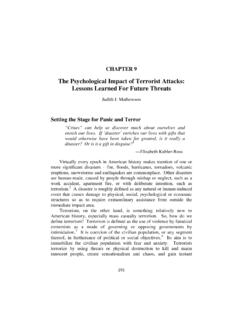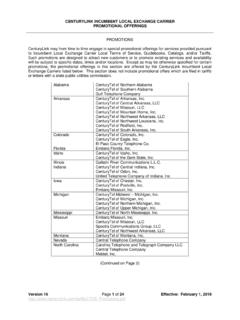Transcription of UNDERSTANDING CENTERS OF GRAVITY AND …
1 UNDERSTANDING . CENTERS OF GRAVITY . AND critical vulnerabilities . by Dr. Joe Strange, USMC War College and Colonel Richard Iron, UK Army Part 1: What Clausewitz (Really) Meant by center of GRAVITY Ambiguity, artificial restrictions and contradictions regarding CENTERS of GRAVITY still exist, despite recent progress. In the past few years the Joint Community has come a long way regarding concepts and definitions of CENTERS of GRAVITY (CGs) and critical vulnerabilities (CVs). CENTERS of GRAVITY are now clearly equated to strength, and critical vulnerabilities equated to weakness. It is acknowledged that multiple CGs may exist at a given level of war; that they may change from phase to phase within a campaign; and that they can change unexpectedly when an enemy shifts the weight of its attack, thus uncovering or relying on a previously unforeseen center of GRAVITY .
2 1. Nevertheless, ambiguity, artificial restrictions and contradictions still abound. For example, Joint Forces Staff College (JFSC) Pub 1 contains the following sentences back- to-back: CENTERS of GRAVITY are the characteristics, capabilities, or locations from which a military force derives its freedom of action, physical strength, or will to fight. At the strategic level, CENTERS of GRAVITY might include a military force, an alliance, a set of critical capabilities or functions, or national strategy itself. 2 First, according to the Joint definition a military force cannot be a center of GRAVITY , yet it is included in a series of potential examples. Secondly, the Joint definition compels one to choose a characteristic, capability OR a location from which .., whereas in many real world scenarios these three requirements often must exist simultaneously in mutual dependency.
3 A force defending a given location would often invariably be ineffective without also possessing essential characteristics and capabilities. Thus when location' wins the label of CG the other two terms/requirements appear to be taken for granted, , mere givens. Thirdly, phrases such as the foundation of capability, the hub of all power and movement, and dominant characteristics are ambiguous enough. Worse, they are invariably supported/illustrated with an expansive laundry list of examples to include an alliance, 1. the community of interest, public opinion (an imprecise term by itself), and even national strategy itself. 3 Marine Corps Doctrinal Puplication 1 Warfighting (MCDP 1). contains one of the best (or worst) examples of the scatterization of the concept or term of center of GRAVITY to mean any feature of friendly or enemy strength that strikes a commander and/or his staff as being preeminently central in a given Words and phrases such as critical , the key, the crux, and everything hinges upon, by themselves are not accurate indicators of CENTERS of GRAVITY .
4 The commander pounds the table with his fist and exclaims, The port! The port! The port! We can't do a damn thing without it! It is the key to our entire campaign (or strategy). It is our center of GRAVITY . Everything hinges upon it. We must first secure it, and then expand its capacity to process 100,000 widgets a day. How many times have you heard or read something like this? True enough, our port conforms nicely to the phrases foundation of capability' and the hub of all power and movement' a la JFSC. Pub 1; and it certainly is a critical factor' which the commander cannot do without a la MCDP Warfighting. However, a perverted thought process is at play in our port example, and many cases similar to it, whereby commanders and their staffs designate a key logistical or C2 element or suchlike as a center of GRAVITY .
5 That process is driven by a rationale or train of thought in which concurrent and contrasting images of dependence, vulnerability and strength associated with a single preeminently critical factor ( that everything else hinges upon') blend together resulting in said factor being designated as the' or a' center of GRAVITY . Yet, our port will not kill a single enemy soldier, or strike heavy (or effective) blows against enemy forces, or offer any resistance to enemy schemes of maneuver. Nor will it seize a single square inch of key enemy terrain, or wreck physical destruction upon the enemy's military and civil infrastructure. It will support all of those activities, but it will not do any of them. Therefore, our port is not a true Clausewitzian center of GRAVITY .
6 It is instead a critically important requirement necessary to support the real center (or CENTERS ) of GRAVITY that will engage the enemy's physical means to resist and destroy his will to fight. Clausewitz's discussion of CENTERS of GRAVITY in Book Six of On War is clear and straightforward. The 1987 Schneider-Izzo essay in Parameters on Clausewitz's Elusive center of GRAVITY still stands as a solid review of what Clausewitz meant by physical CENTERS of GRAVITY in Book Six of On Having established in Book One the physical nature of war as a collision between armed forces, in Book Six Clausewitz discusses the use of physical force to throw an opponent . In Chapter 27, Clausewitz develops a relationship between these dynamic forces in collision and their locus of action in space, the theater of operations.
7 6 In large countries with large theaters of operations, a division of forces .. becomes inevitable, and with it several theaters of operation.. For this reason, the blow from which the broadest and most favorable repercussions can be expected will be aimed against that area where the greatest concentration of enemy troops can be found; .. A center of GRAVITY is always found where the mass is 2. concentrated most densely. It presents the most effective target for a blow; furthermore, the heaviest blow is that struck by the center of GRAVITY .' 7 A major battle in a theater of operations is a collision between two CENTERS of GRAVITY ;..' 8 Of significance is that Clausewitz clearly distinguishes between what he views as the center of GRAVITY the army itself and those things which FM 100-5 erroneously cites as being examples of CENTERS of GRAVITY .
8 Thus, for instance, he notes that the attacker's lines of communication, rather than themselves constituting a center of GRAVITY , are merely a means through which commanders aim at an immediate decision, a confrontation of the two CENTERS of GRAVITY .' 9 We agree with Schneider and Izzo that Clausewitz's discussion of physical CENTERS of GRAVITY in Book Six (in any of the translations of On War that will be discussed later in this article) is very clear. Schneider and Izzo add that the Germans adopted the concept of the center of GRAVITY , which they called schwerpunkt,10 as a useful operational design tool because of its close association with the principle of concentration of mass or force. In the German language, concentration of mass' is translated as schwerpunktbildung.
9 The success of Nazi-Germany's lightening campaigns during the early years of World War II depended largely upon the rapid shifting and deployment of concentrations of armored forces. These armored forces, thus concentrated, constituted in the German view the schwerpunkt or center of GRAVITY of the operation. 11 Schneider and Izzo conclude their essay with a discussion of the German UNDERSTANDING of opposing CENTERS of GRAVITY (opposing schwerpunkten) during the battle for France in In October and November 1939 the Germans changed their attack plan by shifting their center of GRAVITY seven panzer and three motorized infantry divisions (backed up by thirty-five regular infantry divisions) south to the Ardennes region. What made this (Manstein) revision decisive was that the Allied center of GRAVITY , located with the mass of forces to the north, was about to pivot around Sedan eastward into Belgium.
10 German seizure of Sedan would place the newly constituted German center of GRAVITY on the flank and rear of the Allied center of The further west the Germans could penetrate, the more critical the effect would become. The speed of this movement would ensure the paralysis of Allied command and control."13. This same concept is also seen in Hitler's Directive No. 21, dated 18 December 1940, for Operation BARBAROSSA, the invasion of Russia in 1941: In the operations area divided by the Pripet Marshes into a southern and a northern half the center of GRAVITY is to be formed north of this area. Here two Army Groups are to be envisaged. The more southerly of these two [northern] Army Groups .. has the task of bursting forward with particularly strong Panzer and motorized formations from the area around and north of Warsaw and of smashing the enemy forces in The Army Group deployed south of the Pripet Marshes must form its center of GRAVITY in the Lublin area in the general direction of Kiev, in order to advance rapidly with strong panzer forces into the deep flank and rear of the Russian forces and to roll it up along the Dnieper.
